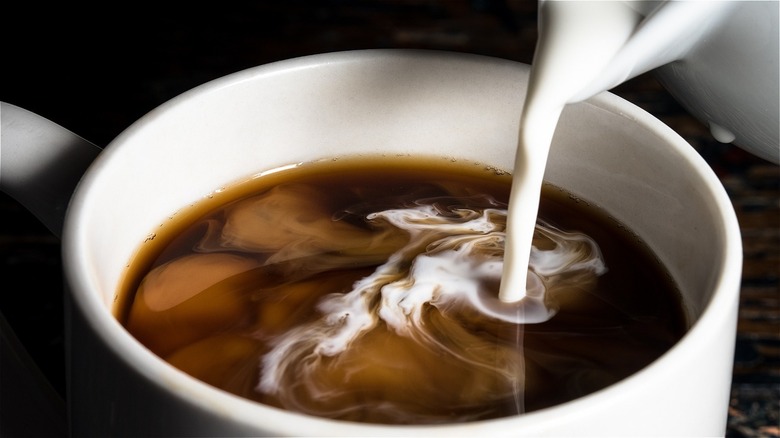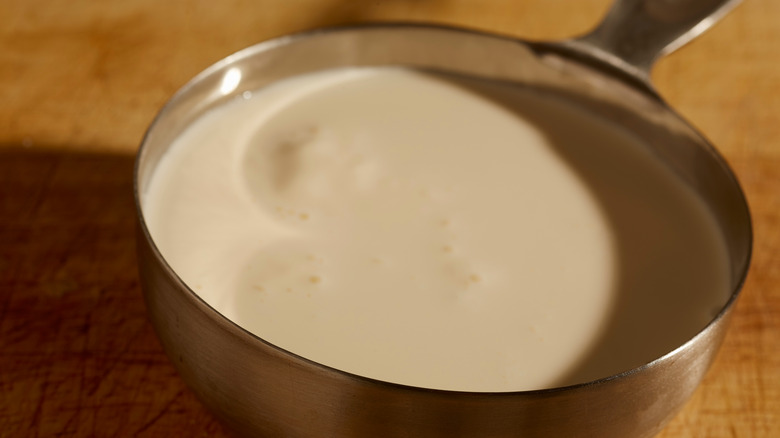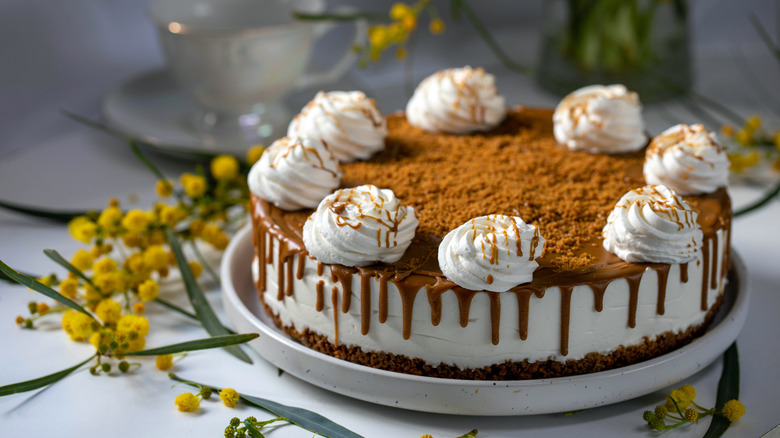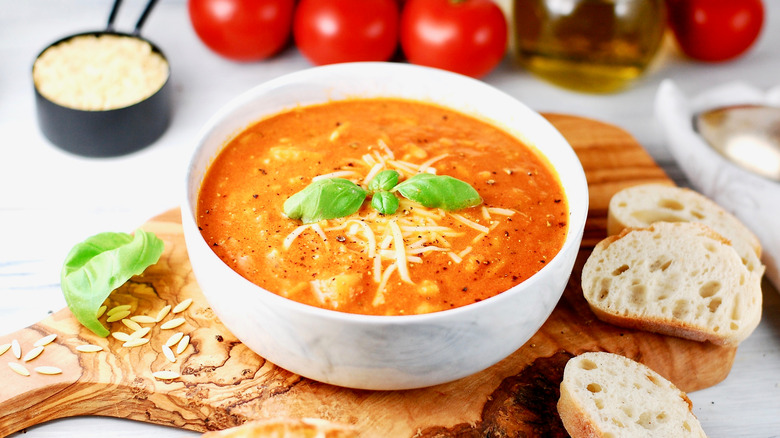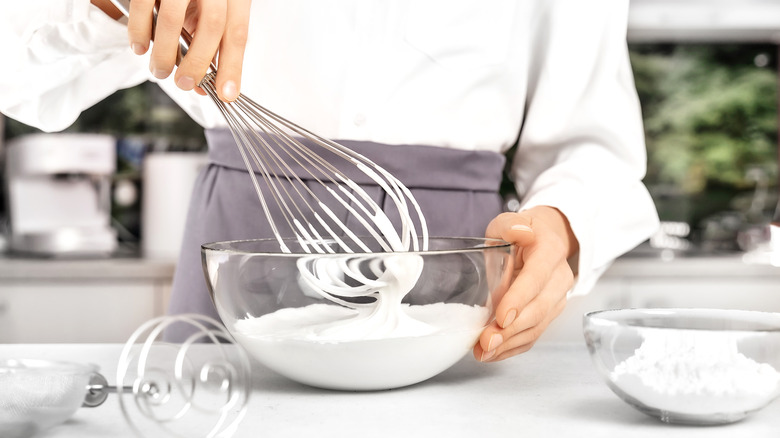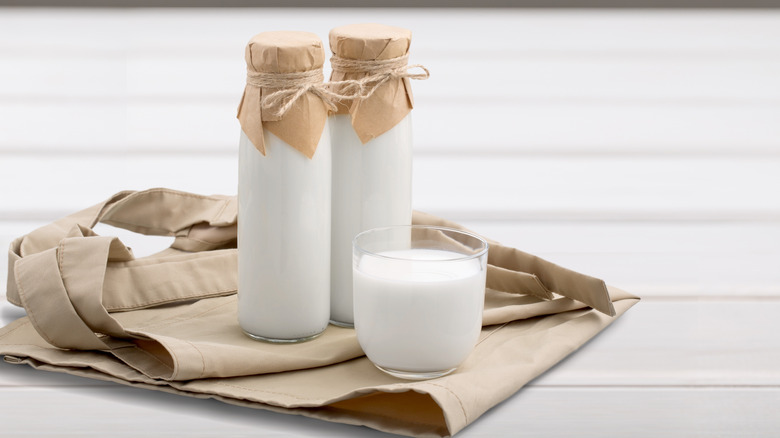Double Cream Vs Heavy Cream: What's The Difference?
Humans are the only animal known to regularly drink the milk of another species, and we've been consuming animal milk for at least 6,000 years, according to the journal Nature. Historically, there has been a nutritional motivation for this when food was in short supply, but our modern affinity for dairy products like luscious cream transcends any imperative to survive as a species. Found in so many foods — from bisques and saucy dinner entrees to desserts and even half-and-half in coffee — cream is ubiquitous. We love it so much that "creamy" is one of the words that signal how delicious a dish tastes. The ingredient is loved because of its rich flavors and incredibly smooth texture.
You've undoubtedly seen a carton of cream or even whipped some up as a topping for your favorite pie or berries. But there are several types of cream, which can become a little confusing. If you've ever happened upon a container of "double cream" at the grocery store, you might have felt a bit thrown by this less familiar phrase. Simply put, double cream is the term commonly used in Great Britain for what is called heavy or whipping cream in North America. However, there are subtle differences and some information you should know about these two products.
What is double cream?
First, what exactly are we talking about when we refer to cream as a dairy product? Well, cream is the layer of fat that accumulates on the surface of a container of unhomogenized milk. This layer can be skimmed from the milk before homogenization, or the process that breaks down fat into minuscule parts that are dispersed throughout the milk, and used in the production of cream. However, double cream is produced by subjecting unhomogenized milk to centrifugal force to separate the butterfat from the milk.
In the U.K., double cream is used in a similar way to heavy cream or whipping cream in the U.S., but there is a difference: Double cream has a higher butterfat content, so it is much richer. In the U.S., whipping cream has a butterfat content of 30% and heavy cream or heavy whipping cream is 36% to 38% butterfat. Double cream, on the other hand, has a butterfat content of at least 48%.
What is heavy cream?
There are two types of creams you are likely to encounter at your local grocery store: whipping cream and heavy cream. Whipping cream, with 30% butterfat, works well for toppings and fillings, but it won't thicken quite as well as heavy cream when whipped. So what's heavy cream? Sometimes referred to as heavy whipping cream, it has between 36% to 38% butterfat and is a bit thicker when whipped. In fact, whipping it causes the heavy cream to double in volume. It also holds its shape better than whipping cream.
You can't really go wrong with either cream because they are pretty much interchangeable. Just remember that when whipped, whipping cream will give you a lighter and airier result and it won't hold its peaks as long as heavy cream will. If you are making soups, either cream will do, although heavy cream will give you a richer, creamier texture.
How is double cream used?
Using double cream for whipped cream yields a thicker, richer whipped topping with stiffer peaks than can be achieved with heavy cream or whipping cream. Take care not to over-whip double cream, however, because this could lead to you making your own butter instead of achieving your desired airy topping. Double cream also makes for very rich cream soups. Because of its high fat content, double cream resists curdling, which makes it great to use in sauces. Double cream can also add extra richness to risotto.
The British use double cream as a pouring cream to serve on top of pies and other desserts the way that some Americans would use ice cream. Cook's Info offers another idea for using double cream in desserts: When making a fruit pie, remove the pie from the oven just before it is fully baked. Pour some double cream through the vent in the pastry and return it to the oven for 10 minutes for a creamy fruit pie.
Can you substitute heavy cream for double cream?
Double cream is difficult to find in the U.S. However, you can substitute heavy cream for double cream when making whipped cream or for cooking. But you should avoid ultra-pasteurized heavy cream, as these are more difficult to whip and do not have the fresh flavor that less pasteurized heavy cream does.
Authentic English double cream is often served with scones, but for this type of application, you can substitute some creme fraiche or mascarpone cheese, which has a rich and buttery flavor. Heavy cream and creme fraiche can also be used for sauces that call for double cream.
It should be noted that substituting whipping cream for double cream can be harder to do. For sauces that are acidic, like tomato sauce, remove the pan from the heat before adding the whipping cream, as less fatty creams could separate. For the same reason, you should not return the sauce to a boil once you have added the cream.
How to make double cream
Surprisingly, if nothing but double cream will do, you can make a reasonable approximation of it yourself. No, there are no cows required. It's as simple as combining 1 cup of heavy cream with 1 tablespoon of buttermilk. Pour the contents into a jar with a lid and shake the mixture for one minute. Next, wrap the jar in a thick towel, and let it stand at room temperature until it is very thick, but still a liquid. This should take about 12 hours.
You can also make your own version of double cream by pouring ½ gallon of whole milk into a large pot and heating it to a soft boil. Next, using a slotted spoon, skim the fats that rise to the top of the milk and transfer them to an air-tight container. Refrigerate the fats for a day, then pour them into a blender to dissolve any lumps, and your double cream will be ready to use.
